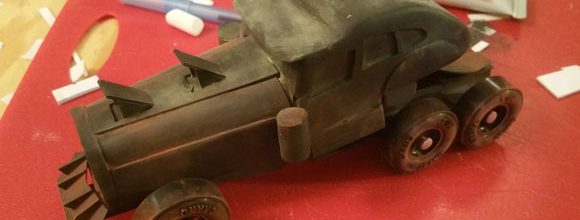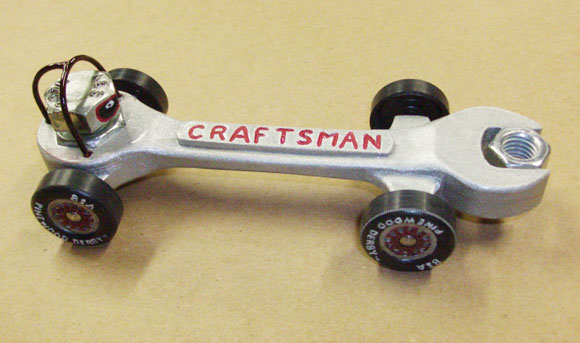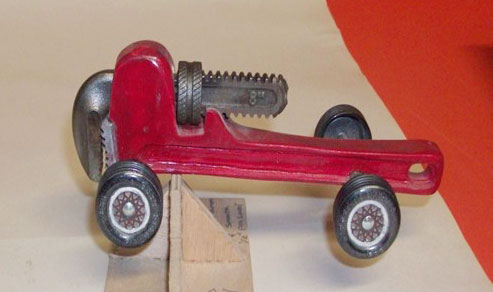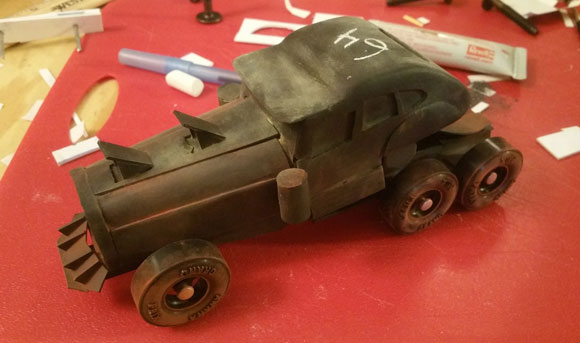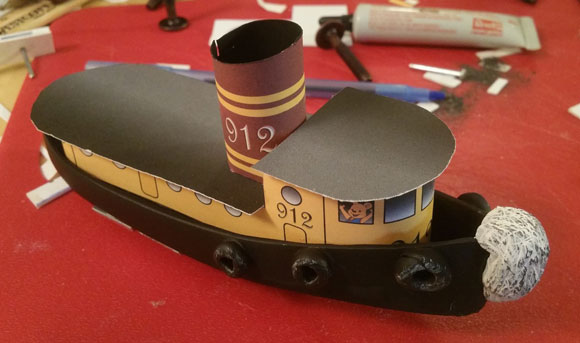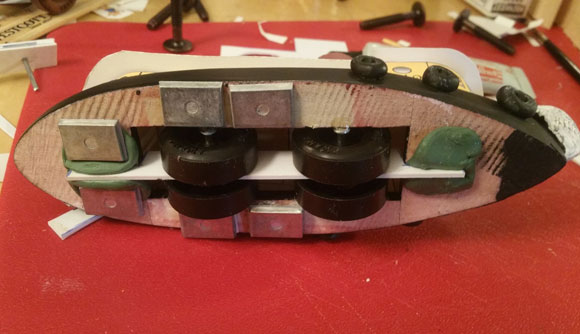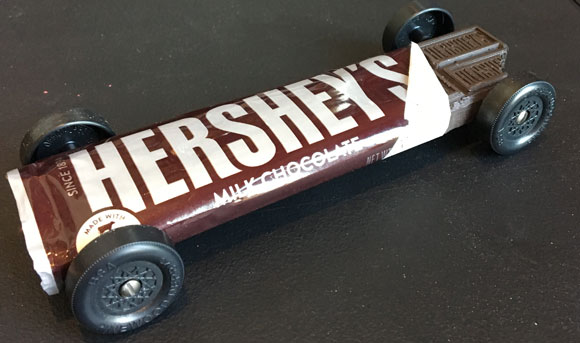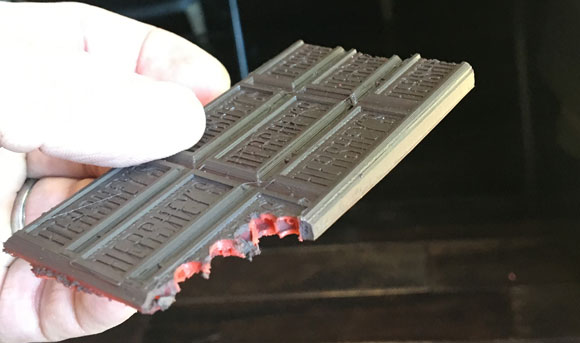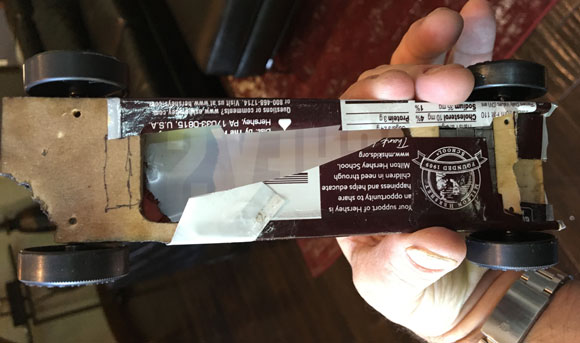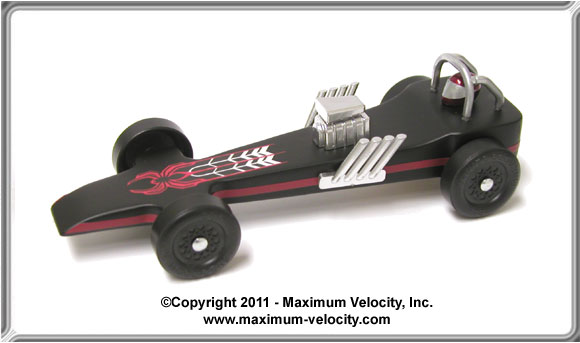In this Edition
– Editor’s Notes
– Feature Article: Is it Cheating?
– Humor
– Product Showcase: One Set of BSA Speed Axles for 1 Cent
– Pinewood Derby Car Showcase
– Pinewood Derby Memory: Hard Work Pays Off
– Q&A
Editor’s Notes
Reader Feedback
We received this note from Mark Robison regarding our recent article on using hardware for last minute weighting:
“I enjoyed your last newsletter on last minute weight ideas from the hardware store. I’ve built a few cars using some of the ideas you shared about using nuts and bolts. Here is one of them, “The Craftsman”.
Here’s one that is probably not the most traditional way of weighting a pinewood derby car: “The Pipe Wrench”.
The car body is wood, but the jaws are from an 8 inch pipe wrench. The COG ended up at 3/4 inch, with a total weight of just under 5 ounces.”
MV Basic & Wedge Car Kits

– Quality Block – Unlike the blocks provided by some organizations, our blocks are soft, northwestern pine blocks, cut precisely to 7 inches long, 1-3/4 inches wide, and 1-1/4 inches tall. These dimensions, as well as the axle slots accurately duplicate the dimensions of standard pinewood derby blocks from BSA and PineCar.
– Simple Axle Preparation – Don’t worry about filing off flaws, or losing hub caps. Our Speed Axles have no burrs or crimp marks, and install without hub caps. With or without polishing, they are ready to go. We supply five, so you have a spare.
– Quality Wheels – Forget cheap, out of round wheels. Our MV wheels are top-quality wheels. You will not be disappointed with the quality of these wheels.
So, if your organization does not mandate a particular kit type, consider our MV Basic Car Kits or MV Wedge Car Kits. We also offer bulk packs of MV kits in Pre-cut Shapes.
Inventory Clearance Sale
We are clearing inventory on several items including:
– Tungsten & Tundra Weights
– Formula One, Barracuda, and Vector car kits
We don’t have many remaining, so don’t delay.You can find these items Here.
Can We Help?
If we can help you in any way with your pinewood derby project, or if you have any feedback regarding this newsletter, please Contact Us.
Feature Article
Is it Cheating?
By Randy Davis
This past year I received several e-mails relating situations where car builders were accused of cheating. In some cases, the writer of the e-mail was certain that another parent had cheated, and in other cases the writer was accused of cheating.
In several of these cases, I disagreed with the accusation. I am certainly against cheating, but before an accusation of cheating can stand, there must be an understanding of the definition.
According to the dictionary, to cheat is “To violate rules deliberately, as in a game”. Thus, for cheating to occur, the following must occur:
- Breaking a clearly documented rule,
- Deliberate act.
To put this into pinewood derby terms, for cheating to occur:
- There must be a clear, written set of rules governing the construction of the car,
- The car owner must knowingly violate a particular rule.
This may seem like a narrow view to some, but let me share some situations that will (hopefully) make this clearer.
Lack of Rules or Rule Clarity
The rules that come with the BSA Car kit and with the Awana Kit are notoriously vague. Many packs, districts, and councils have annotated these rules for their own use, but many others still use the rules in the box alone. This can lead to accusations of cheating when the interpretation of the rules in the box varies. Here is a case in point from a newsletter subscriber:
“Our pack had no printed rules other than those in the BSA kit. In addition, I was told by the pack leaders that the only rules were 7 inches long, 5 ounces maximum weight, and 3/8-inch ground clearance minimum. So, we put the car together and complied with these rules. We did use axle holes (instead of slots) and had a three wheel on the ground setup.
When the car was inspected at the race, the inspector said we should have used the slots on the bottom of the car so that the axles could be seen. This was the first we had heard of this rule. After a brief discussion with the officials we were allowed to race (our car, built in 2 days, was one of the shabbiest looking entered in the derby).
Well, the car won every heat in the den by at least 2 car lengths. Suddenly everyone was protesting our axle holes. One family in my son’s den had won the den and the overall pack race three years in a row and they were irate! The race officials conferred, and we were told that we would have to cut axle slots in the car to be able to compete in the overall pack race. If we didn’t cut the slots we would be disqualified as the den champion! Knowing we were legal, we consented and pulled the wheels and cut the slots in the car. All of this was done with no alignment tools other than a credit card for wheel spacing. We were pressed for time and pushed the axles into the original holes that had been drilled into the body. The axles could now be seen, but the axles were only held in by friction, as we didn’t have any way to glue them in place …” (1)
(Edited and names removed to maintain anonymity)
What happened here? Did the car owner cheat? Did the previous champion have a valid issue? Were the race officials justified in their actions? In my opinion, the car owner followed the rules (there is no mention of axle holes or slots in the ‘Rules’ section of the paper in the BSA kit), the previous champion had no valid issue, and the officials should be ashamed of themselves for changing their previous ruling during the middle of the race.
Is this an isolated incident? I wish it were so. I receive numerous e-mails every year with a similar theme. Here is another one:
“My boy and I have been lucky enough to win three 1st Place trophies. I do own a very good drill press, and I built our own test track. But, my biggest challenges have been working with my son to understand all of it, patience to do it all, and, most of all, dealing with the aftermath of winning because he gets accused of cheating. After our first win he was not allowed to enjoy the good feelings that should have accompanied the 1st Place trophy. The judge – who inspected his car and approved it for racing – threatened to disqualify it after it won the first three heats (two of them were against his son). After the trophies were passed out, he informed both of us (loudly, and in front of all) that when we went to District that we would be disqualified if we left the graphite on the outside of our wheels. We weren’t, but most of the Moms and Dads who heard what he said told their boys that my son and I had cheated …”
(Edited)
Did cheating occur in this situation? The car evidently met the rules and was allowed to race with no issue. The victory was not due to a rule violation but was due to the amount of time and effort put in by the parent/child team. (2) Clearly, the accusations had no merit and were just due to “sour grapes” on the part of the race official. What a display of childishness.
I could go on, but I believe the point is made. A different interpretation of a vague rule does not constitute cheating.
Deliberate Act
While the major source of cheating accusations is due to vague rules, it can also occur when people are unaware of the rules. This oftentimes happens to people who are new to pinewood derby racing or have previously participated in the event in a different organization. The following can happen:
“We built a car for my Cub Scout’s pinewood derby race. We had previously raced in the Awana Grand Prix and had done quite well. So, we built a car using the same techniques – long wheelbase, three wheels on the ground, etc. At the pack we took 1st Place. But when we went to the district race, our car was disqualified because of the long wheelbase. Of course, there was nothing we could do. Another member of the pack was at the district race and witnessed the disqualification. The boy told my son that we had cheated at the pack race …”
Was this cheating? Apparently, the long wheelbase car was acceptable at the pack race so there was no cheating at that event. Since the car violated the district rules, it was rightfully disqualified. Since the car never raced at the district, the car owner certainly couldn’t be accused of cheating. Too bad that the district and pack rules were not synched up.
A slightly different scenario can also occur: a car violates the rules, but the violation is not caught at inspection. Later – usually when the car does well in the heats – the violation is detected, and the owner is accused of cheating. This is a more difficult situation that can take on two flavors:
- The rule violation was obvious, but for some reason was missed, or
- The rule violation was hidden, but somehow became known during the race.
Let me provide an example for each. These situations do arise, so officials should be prepared with a response.
- The rules specify that the car must ride on all 4 wheels. A car is entered with only three wheels on the ground (a very easy thing to unintentionally do). The violation is not detected. Later, while the car is being staged, the starter notices the violation. Should the car be disqualified? Is it cheating? (3)
- The rules specify that no moving parts are allowed except for the wheels. During a heat, a car crashes and mercury comes spilling out (this actually occurred in early 2004 at a BSA race in Kansas). Was this cheating?
In case 1, in the highest likelihood the violation was unintentional. The owners would have had every reason to believe that the violation would be detected at the inspection, so to intentionally attempt the illegal technique would have been pure foolishness. What should be done when the illegality was detected in the race? In my opinion, since the car passed inspection and was allowed to race, no action should be taken. The car should be allowed to continue racing. The pack should make sure to improve their car inspection check list before the next derby event.
In case 2, cheating may or may not have occurred. It is possible that the parent did not consider mercury a “moving part”, and equally as possible that the parent knew, but gambled that it would not be detected (of course in either case, the parent showed highly questionable thinking by using a toxic substance in the car). Since the rules specified no moving parts, and since the detection of the mercury would have been virtually impossible at inspection, I recommend disqualifying the car. The situation would be the same if during the race a wheel came off and it was found that a hidden bearing or bushing was used, or that illegal axles were used.
Clearly, this is a gray area, so to avoid problems and legislating from the bench, set a policy ahead of time as to how to respond to illegalities found after inspection.
Conclusion
Certainly, cheating does occur. But to avoid false accusations make sure there are clear rules in place, and there is a clear intent to violate a rule. Remember also that pinewood derby racing is a child-oriented activity. Parents, keep it fun by avoiding unnecessary conflict.
(1) The car ended up taking 2nd Place in the pack.
(2) Consistent winners are oftentimes accused of cheating, especially if their car is significantly faster than other cars. While it is possible that some illegal technique is being used, more likely they know all the speed techniques, are taking every possible advantage offered by the rules, and put a lot of time into constructing the car. Working smart and working hard generally pay off (See the “Pinewood Derby Memory” in this newsletter).
(3) The night before I wrote this article I helped at a local race. The rules specified using the wheels that came with the distributed kit (MV wheels), but someone showed up with a car that had PineCar wheels. The inspector didn’t catch the wheel difference and the car passed inspection. I spotted the wheels just before the race and mentioned it to the race leader. But we agreed at that point to let the car run.
Humor
Why God Made Moms
Answers given by Second Grade school children to the following questions:
Why did God make mothers?
- She’s the only one who knows where the scotch tape is.
- Mostly to clean the house.
- To help us out of there when we were getting born.
How did God make mothers?
- He used dirt, just like for the rest of us.
- Magic plus super powers and a lot of stirring.
- God made my Mom just the same like he made me. He just used bigger parts.
What ingredients are mothers made of?
- God makes mothers out of clouds and angel hair and everything nice in the world and one dab of mean.
- They had to get their start from men’s bones. Then they mostly use string, I think.
Why did God give you Your mother and not some other mom?
- We’re related!
- God knew she likes me a lot more than other people’s moms like me.
What kind of little girl was your mom?
- My Mom has always been my Mom and none of that other stuff.
- I don’t know because I wasn’t there, but my guess would be pretty bossy.
- They say she used to be nice.
What did Mom need to know about dad before she married him?
- His last name.
- She had to know his background. Like is he a crook? Does he get drunk on beer?
- Does he make at least $800 a year? Did he say NO to drugs and YES to chores?
Why did your Mom marry your dad?
- My dad makes the best spaghetti in the world, and my Mom eats a lot.
- She got too old to do anything else with him.
- My grandma says that Mom didn’t have her thinking cap on.
Who’s the boss at your house?
- Mom doesn’t want to be boss, but she has to because dad’s such a goof ball.
- Mom. You can tell by room inspection. She sees the stuff under the bed.
- I guess Mom is, but only because she has a lot more to do than dad.
What’s the difference between Moms and dads?
- Moms work at work and work at home and dads just go to work at work.
- Moms know how to talk to teachers without scaring them.
- Dads are taller and stronger, but Moms have all the real power ’cause that’s who you got to ask if you want to sleep over at your friend’s.
- Moms have magic, they make you feel better without medicine.
What does your Mom do in her spare time?
- Mothers don’t do spare time.
- To hear her tell it, she pays bills all day long.
What would it take to make your Mom perfect?
- On the inside she’s already perfect. Outside, I think some kind of plastic surgery.
- Diet. You know, her hair. I’d diet, maybe blue.
If you could change one thing about your Mom, what would it be?
- She has this weird thing about me keeping my room clean. I’d get rid of that.
- I’d make my Mom smarter. Then she would know it was my sister who did it and not me.
- I would like for her to get rid of those invisible eyes on the back of her head.
Product Showcase
One Set of BSA Speed Axles for 1 Cent
Say “Goodbye” to burrs and crimp marks! These BSA Pinewood Derby Speed Axles are precision-made to replicate the official BSA nail, but without the burrs and crimp marks.
Benefits:
- Accurate, round shaft to improve performance,
- No burrs and crimp marks, eliminating tedious work
- Axle head is slightly and accurately beveled to minimize contact with the outside wheel hub
- Axle head is round and centered on the axle shaft
- Shaft has a shiny plated surface. You can use the axles as is, or polish them with our Axle Polishing Kit or with our Axle Polish.
But through November 27, 2018, you can get one set of BSA Speed Axles for one cent. To take advantage of this limited time offer, a set of BSA Speed Axles to your shopping cart and use coupon code NOV14NL during checkout.
Pinewood Derby Car Showcase
War Rig – Dennis Pemberton
My wife and I are both Awana leaders, and we make cars every year. My car was based on the War Rig from Mad Max Fury Road – which I have not seen but has loads of cool cars. The cab is wood sheeted with styrene and wheels are mounted on a styrene sheet suspension. It ran surprisingly well given the high center of gravity and general heavy design.
Tugboat – Christy Pemberton
Our Awana track is extruded aluminum (hollow lane guides) which enabled my wife to make this tugboat. The wheels are inside the car, mounted on a sheet-plastic keel. The car ran okay, but it was mainly built as a proof of concept car.
Hershey’s – Derek Braziel
For my son’s pack race, we built a Hershey bar. My son loves those. We used a 3D printer to print out a fake bar and then used a Dremel to just use the top half of the plastic model. The plastic was very light – much lighter than real chocolate!
I used a basic 1/4-inch wood plank with weight pockets. I hollowed out the middle to lighten the car further. In addition to the tungsten weights you see, I put a full ounce of Tungsten Putty on top (like a canopy weight) so the wrapper had an arc.
We were going for most creative AND speed this year. It is “engineered” to win but my Wolf Scout and I are not great woodworking craftsmen.
Share Your Car with Our Readers
Do you have a car you would like to “show off” to our readers? If so, send us a photo of your car along with a description of any special features to: in**@**************ty.com
Please include your full name. If selected, we will include the photo and description in this newsletter.
Photos must be sent by e-mail in JPG format (minimum size of 640×480, maximum size of 1280 x 960). Please shoot photos from the front left of the car, similar to the orientation of car shown at:
For better focus, keep the camera four or five feet away from the car, and then use the camera’s zoom to fill the frame with the car. Also, use a solid (preferably white) background for the photo.
Send only one photo per car, unless an additional photo is needed to adequately show a feature. Also, only one car per subscriber per year please. Thanks.
Pinewood Derby Memory
Hard Work Pays Off
We just completed our pack’s pinewood derby last weekend. My son and I have been building cars for several years. Each attempt was better than the previous one, but still we had always come up as an also ran. This year we dedicated ourselves to having the fastest car at the race. After all, this was his last year for Cub Scouts, so it was do or die!
We purchased several products: the Pro-Wheel Mandrel, Pro-Hub Tool, Pro-Outer Hub Shaver, and Axle Polishing Kit. With the tools and supplies we had acquired in previous years we had a full suite of tools.
How to use all this? Well to be serious you need some decent test equipment. My son and I built our own one lane test track. While it wasn’t the smoothest and most precise track on earth it did provide for some good testing. I outfitted the track with a timer system I built around a hand stop watch. The watch was good to .001 seconds and was one of the more expensive items ($20.00). I wired in a start switch and rigged up an optical sensor with interface electronics to record the car as it went through the finish lane. It all wired into the start/stop switch in the watch! Remarkably the whole track and timer cost us under $50.00 to build.
The test track allowed us to test wheel combinations, axles, lube types, car center of gravity, etc. We spent almost a week optimizing the final wheel, axle, and weight distribution in our car! My wife was about ready to kill both of us as all we talked about was Pinewood Derby!
Race day came, and we passed all the technical checks. Yet we were a bit hesitant to let go of the car! I talked to my son several times about not getting disappointed if we were not the fastest. What was important is that we worked together and had a fun time building and testing the car. Well when it was finally time for the races we were both fairly nervous. The first race pitted us in lane one and next to us was one of the known fastest father/son teams from previous years. As soon as the start lever was flipped I could tell we were going to do well. The car rolled true and steady as it slowly pulled away from the other three lanes, beating the nearest car by a full car length. All four runs were the same way. When all was said and done not only did we win the overall race, but we set the track record. We were the only car to combine four runs on the 28-foot track in under 9 seconds. The look on my son’s face was priceless. I was shocked and could hardly believe it. The track has seen hundreds of cars and several years’ worth of races, so you can imagine our surprise.
But when all was said and done, the most important thing in my mind was the lessons we learned. I was able to teach my son that hard work and effort can and does work nearly every time!
Jim Nissen
Do you Remember?
If you have a pinewood derby story that is funny, unusual, sad, heart-warming, etc., please send it to me in an e-mail. Don’t worry about literary polish. We will edit as needed before publishing.
If your story is used, you will receive a $10 coupon in May of 2019.
Q&A
Can the 5149 Pro-Axle Guide be used to insert bent/canted axles in axle slots? What about axle holes?
Yes, you can use the Pro-Axle Guide to insert bent axles in axle slots. However, it is best to use the tool to insert a spare axle into a slot position, remove it with a pair of pliers, then repeat for the other three positions. Then when you install the bent axles, they will go in without excessive effort. For axle holes, you just need a Gap Gauge; but if you already have a Pro-Axle Guide, just flip it over and hold the flat side to the bottom of the car. Again, pre-insert a spare axle, twist and pull to remove it, then insert the bent axle.
What grits of sandpaper would you recommend for sanding the car body before painting? I have read different things, but I was wondering what your opinion was.
I recommend using 60, 120, 220, and then 400 grit paper before painting.
Want Answers?
Do you have a pinewood derby-related question? If so, e-mail us your question.We answer all questions by e-mail, but not every question will appear in the Q&A section of the newsletter.
Back Issues
Are you a new subscriber, or have you missed some of the previous newsletters? Don’t miss out; all of the issues for Volume 5 through Volume 18 are posted on our web site.
Newsletter Contributions
We welcome your contributions. If you would like to contribute an article, a web site review, a speed tip, or a pinewood derby memory, please e-mail us.
Subscription Information
The Pinewood Derby Times is a free e-newsletter focused on pinewood derby racing. It is published biweekly from October through March.
If you haven’t already done so, please forward this issue to your pinewood derby friends. But please don’t subscribe your friends. Let them decide for themselves. Thanks.
If this newsletter was forwarded to you, why not subscribe to receive this newsletter. There is no cost, and your e-mail address is safe, as we never sell or share our distribution list.
To subscribe, send a blank e-mail to
pi*********************@*******st.com
You will receive a confirmation e-mail. Reply to the confirmation e-mail and you will start receiving the Pinewood Derby Times with the next issue.
Randy Davis, Editor, Pinewood Derby Times
E-Mail: in**@**************ty.com
(C)2018, Maximum Velocity, Inc. All rights reserved. Please do not reprint or place this newsletter on your web site without explicit permission. However, if you like this newsletter we grant permission, and encourage you to e-mail it to a friend.
Maximum Velocity disclaims any personal loss or liability caused by utilization of any information presented in this newsletter.
The Pinewood Derby Times is not specific to, and is not affiliated with the Boy Scouts of America, YMCA, Awana, or any other organization.
(R)Maximum Velocity is a registered trademark of Maximum Velocity, Inc.
(R)Pinewood Derby is a registered trademarks of the Boys Scouts of America.
(R)Awana is a registered trademark of Awana Clubs International.
All other names are trademarks of their respective owners.

